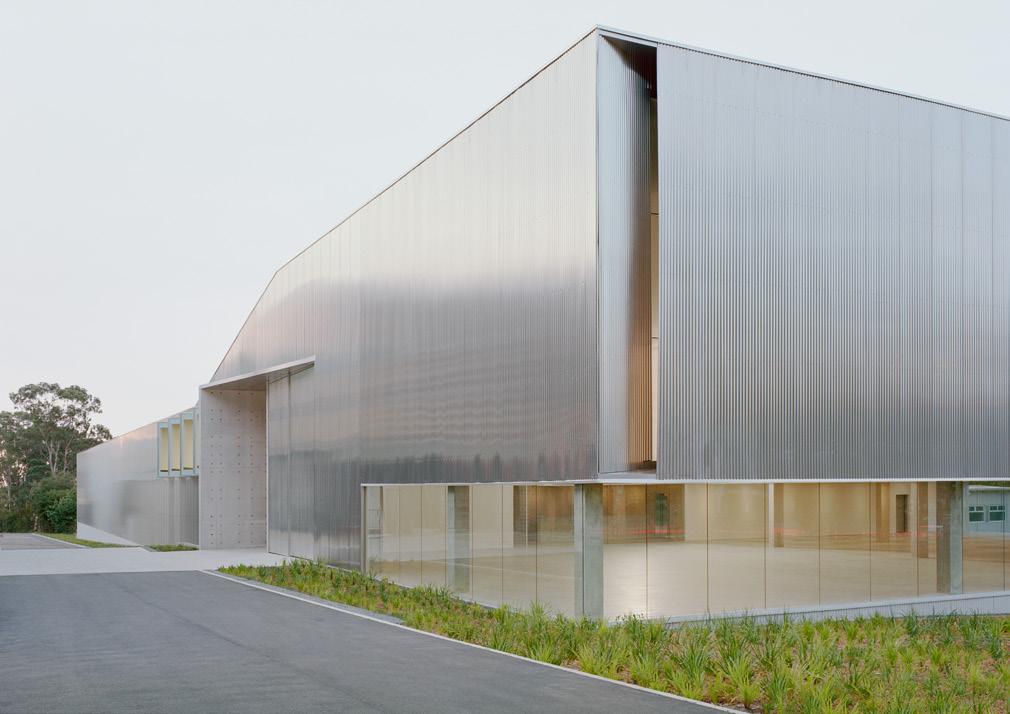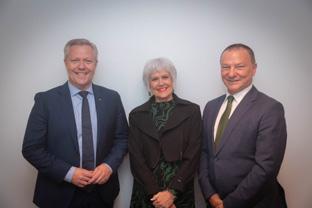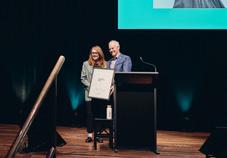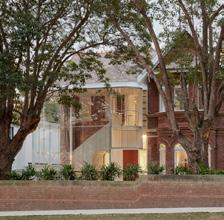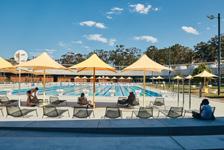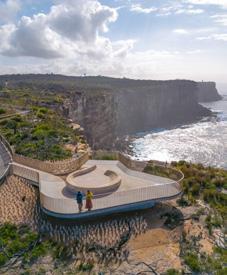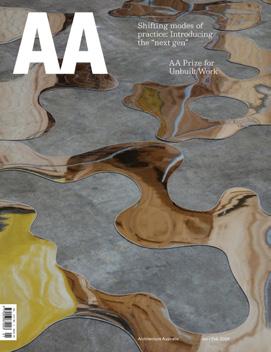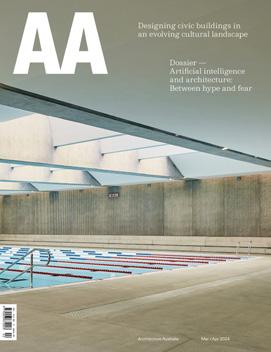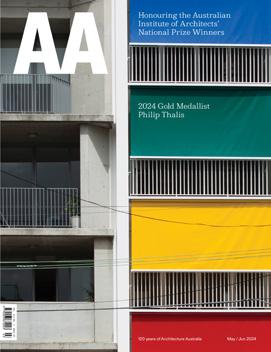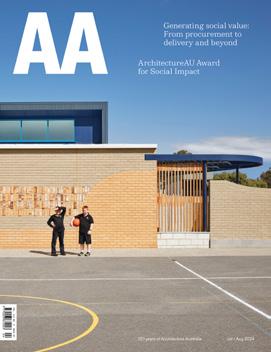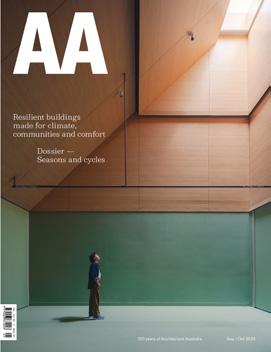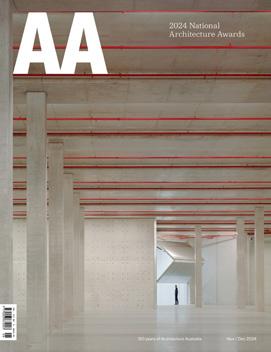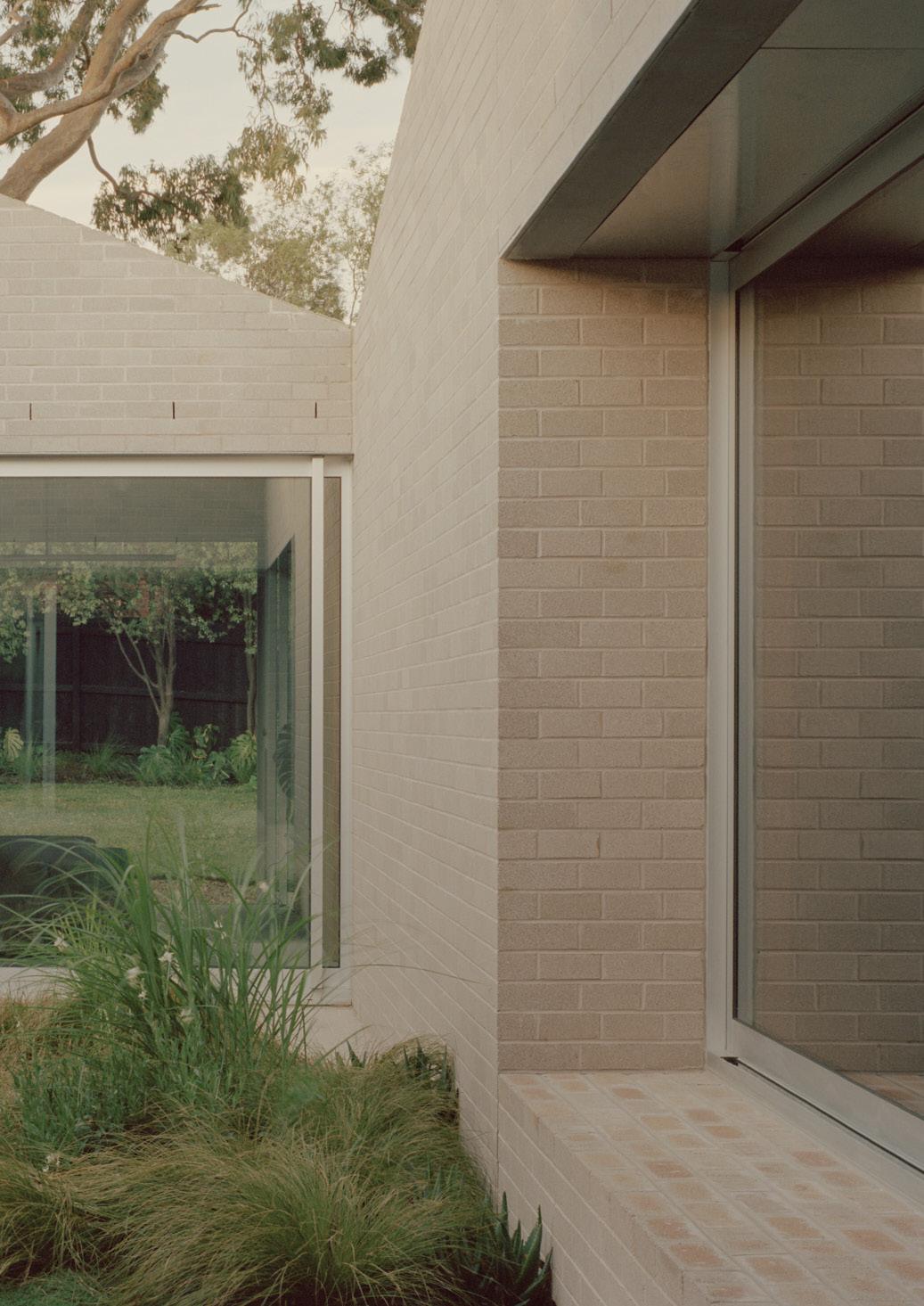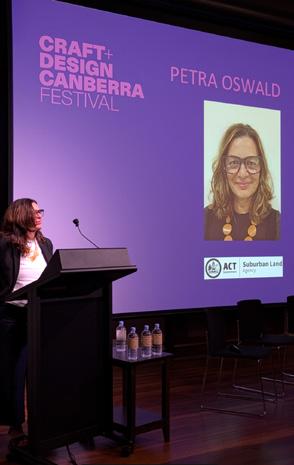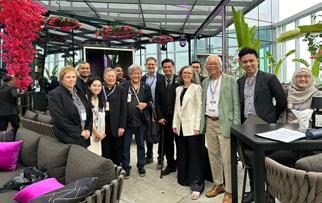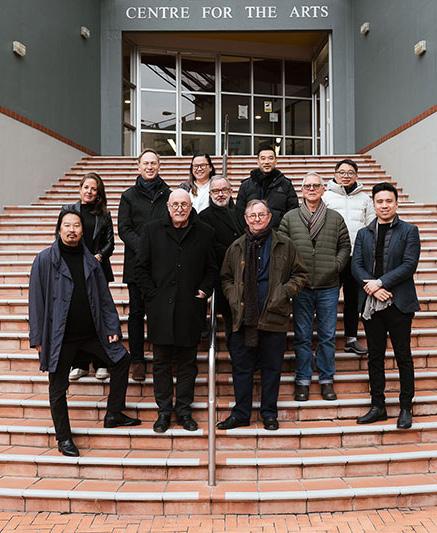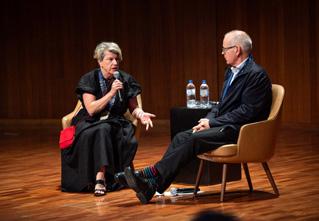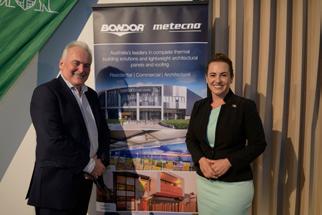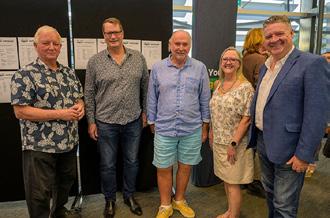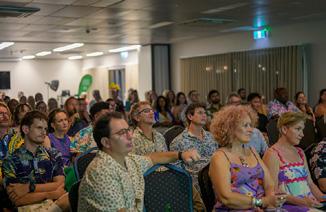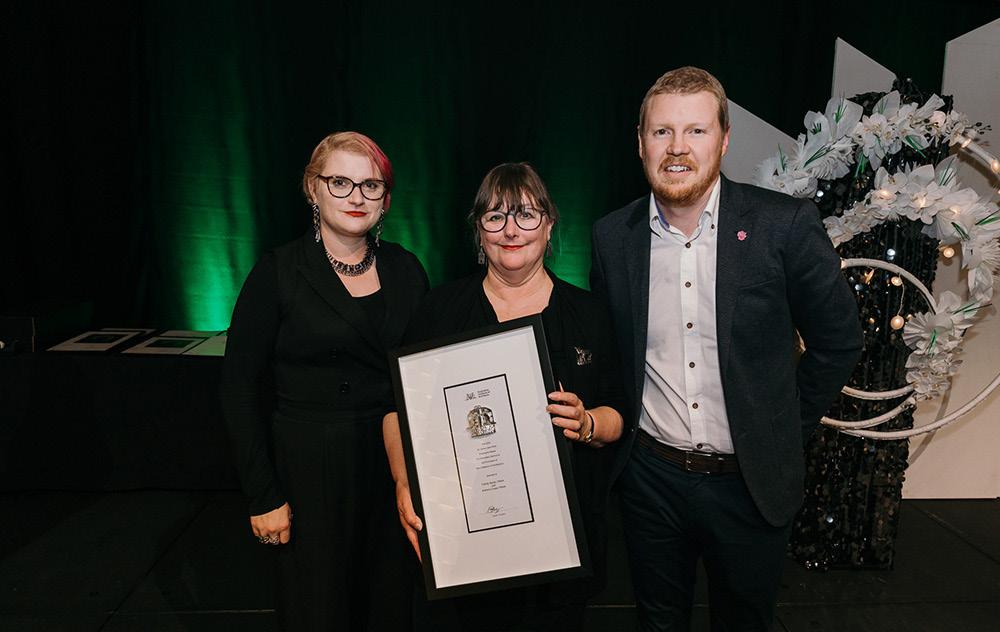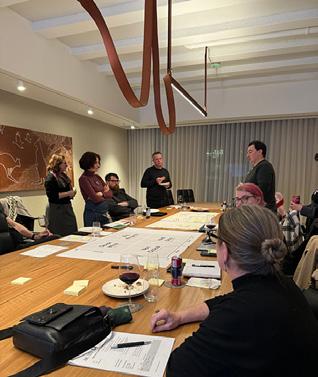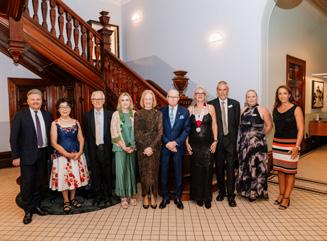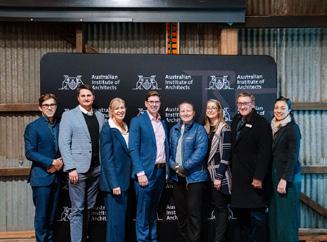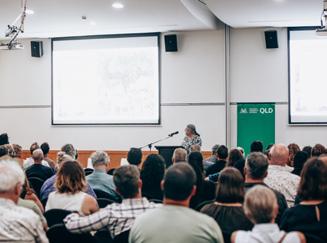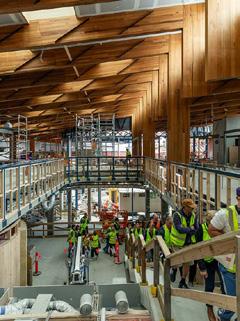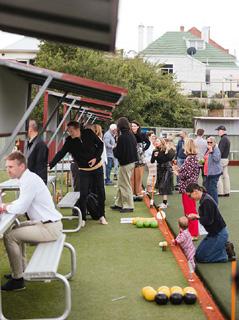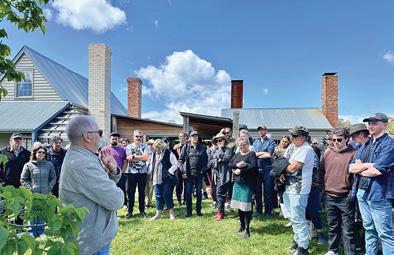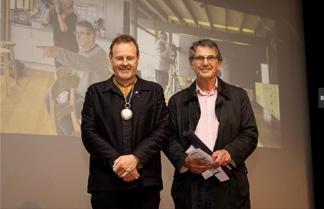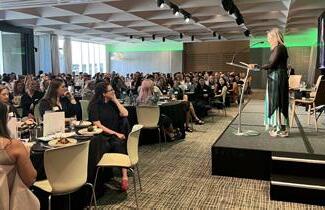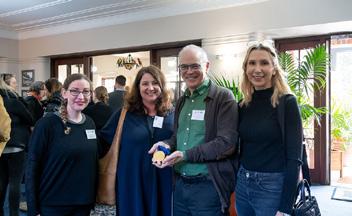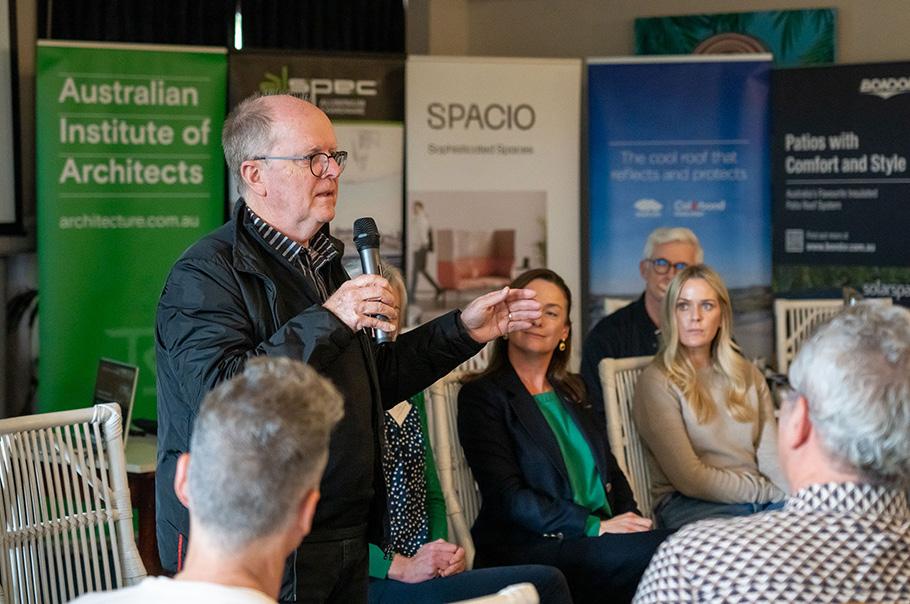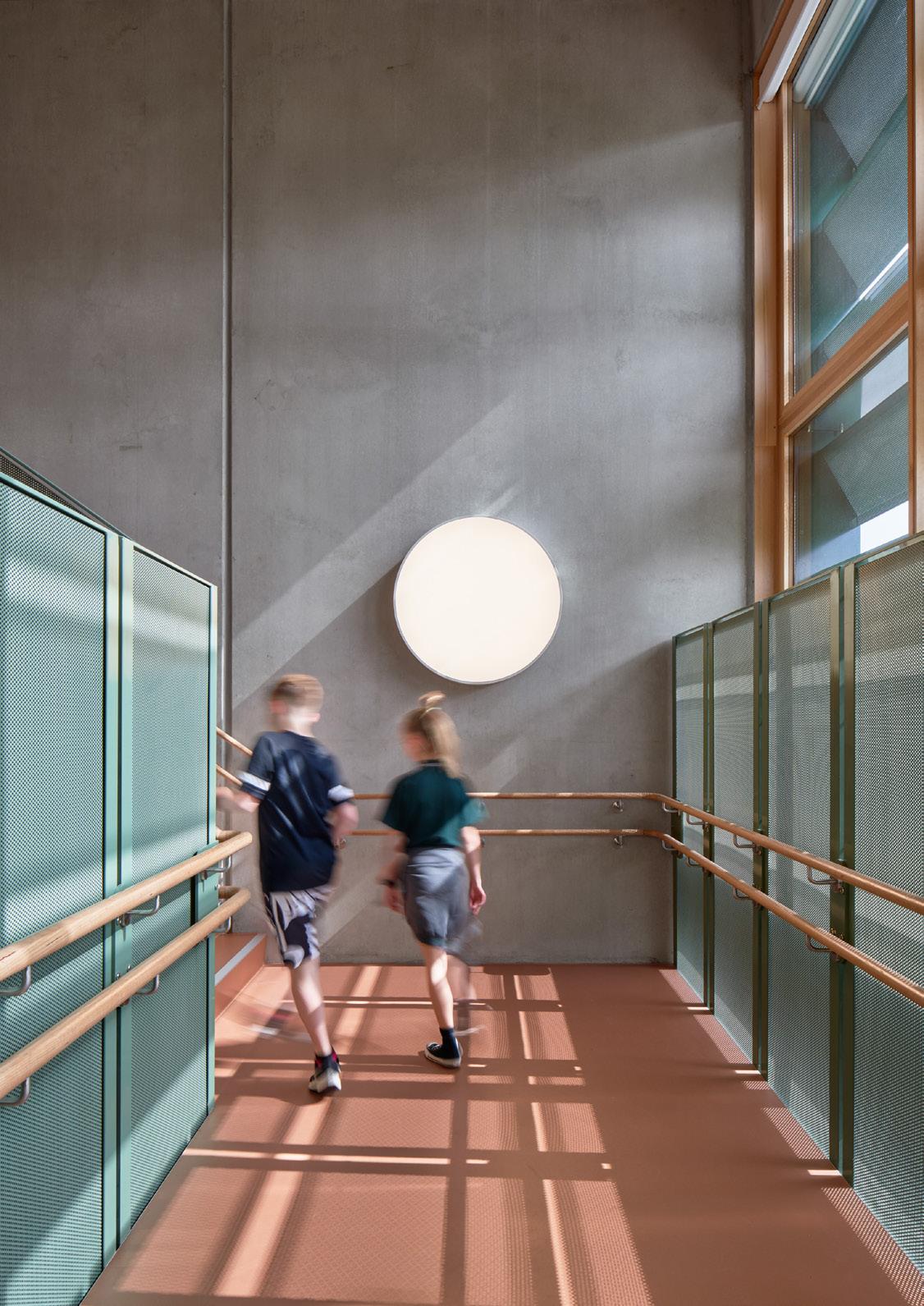Western Australia
The 2024 WA Architecture Awards, which culminated in a fantastic celebration in June. Bob Hawke College Stage 2 by Hassell took out the top honour, receiving the George Temple Poole Award.
The inaugural President’s Honours Dinner, a new tradition celebrating the elevation of our new Fellows.
A well-attended Regional Symposium, which provided meaningful opportunities for exchange across all scales and types of practice.
Continued momentum and leadership from EmAGN and SONA, reaffirming that the future of the profession is in excellent hands.
A calendar of engaging events led by the Gender Equity Taskforce, which were well supported and added valuable perspective to the Chapter’s programming.
Four members were recognised with President’s Prizes, acknowledging their outstanding contribution to the profession and the community.
A successful Perth Parlour Salon held at the Chapter, generating excellent conversation around equity and culture in practice.
The launch of the inaugural ArchiQueers Ball, which proved to be a fabulous celebration of PrideFest WA and a joyful expression of diversity in the built environment professions.
Advocacy and Engagement
The Chapter maintained strong engagement
with stakeholders, actively contributing to policy conversations and government relations:
Chapter President Sandy Anghie led the development of the WA State Government Election Platform, working closely with members and the Institute’s policy team. This resulted in productive dialogue with key government stakeholders.
The WA Built Environment Reference Group (BERG) continued to serve as an important crossindustry platform for collaboration and shared advocacy.
A joint advocacy campaign with the Association of Consulting Architects (ACA) successfully led to the reinstatement of the State Government’s Medium Density Code.
Regular meetings with key figures from government and industry ensured the voice of the profession remained present in key decision-making forums.
WA Chapter Committees and Taskforces continued to provide expert input and advocacy across a range of issues affecting practice and the built environment.
Education and Resources
The Chapter continued to fulfil its commitment to delivering valuable education and resources for members at all stages:
Agreements were renewed with WA’s three schools of architecture to award Colin Mort Scholarships in 2025—supporting “worthy and needy” students to pursue their architectural education.
The Architect magazine remained a flagship celebration of local architectural talent, and work continued on its digitisation, ensuring it becomes a searchable, enduring resource for the profession and public alike.
A strong CPD program was delivered throughout the year, including sessions held in-person at the Regional Symposium and at the Chapter.
Reg/U/Cation sessions continued to support graduates preparing for the Architectural Practice Exam (APE), with practical guidance and mentorship from registered architects.
In 2025 we thank our Past President Sandy Anghie for her tireless efforts and welcome Ross Donaldson as the new Chapter President. The WA Chapter is excited to work with Ross and all our committees and taskforces to deliver an excellent built environment for all West Australians.
Jonathan Speer, Executive Director WA Chapter
Images: 2024 Institute Magazine Launch | Photographer: Dylan Gibbs, 2024 WA Regional Symposium | Photographer: Matt Moyes, 2024 WA Regional Symposium | Photographer: Matt Moyes.
Clifton Hill Primary School Jackson Clements Burrows Architects Photographer: Peter Clarke
The financial statements cover both The Royal Australian Institute of Architects Limited as a Group consisting of The Royal Australian Institute of Architects Limited ("the Company") and the entities it controlled ("the Group") at the end of, or during, the year. The financial statements are presented in Australian dollars, which is The Royal Australian Institute of Architects Limited's functional and presentation currency.
A description of the nature of the Group's operations and its principal activities are included in the Directors' report, which is not part of the financial statements.
The financial statements cover both The Royal Australian Institute of Architects Limited as a Group consisting of The Royal Australian Institute of Architects Limited ("the Company") and the entities it controlled ("the Group") at the end of, or during, the year. The financial statements are presented in Australian dollars, which is The Royal Australian Institute of Architects Limited's functional and presentation currency.
The financial statements were authorised for issue, in accordance with a resolution of Directors, on 3 April 2025. The Directors have the power to amend and reissue the financial statements.
The Royal Australian Institute of Architects Limited is a not-for-profit public company limited by guarantee, incorporated and domiciled in Australia. Its registered office and principal place of business is: Level 1
41 Exhibition St Melbourne VIC 3000
A description of the nature of the Group's operations and its principal activities are included in the Directors' report, which is not part of the financial statements.
The financial statements were authorised for issue, in accordance with a resolution of Directors, on 3 April 2025. The Directors have the power to amend and reissue the financial statements.
The Royal Australian Institute of Architects Limited Controlled Entities Directors' report
31 December 2024
The Directors of The Royal Australian Institute of Architects Limited present their report, together with the financial statements, of the consolidated entity, being The Royal Australian Institute of Architects Limited ('the Company') and its controlled entities ('the Group' or 'consolidated entity') for the year ended 31 December 2024.
Directors
The following persons were directors of The Royal Australian Institute of Architects Limited during the whole of the financial year and up to the date of this report, unless otherwise stated:
Name: Lisa Moore FRAIA GAICD
Qualifications:
B Arch (DU) B Arts (Architecture) Honours (DU)
Experience and other appointments: Appointed as a Director 31 May 2023
Director – And Architecture
Local Government Architect, Sunshine Coast Council from 2021
Member – Sunshine Coast Council Diversity, Inclusion and Advocacy Working Group
Member – AACA Accreditation Standing Panel from 2019
National Councillor from 1 January 2022
Chair – National Education Committee from 2020 to 2022
Deputy Chair – National Education Committee from 2019 to 2020
Chair – QLD Education Committee from 2019 to 2022
QLD Chapter Councillor from 2020 to 2023
Special responsibilities:
Board Chair from 15 May 2024
Member – People and Culture Committee from 31 May 2023 – renamed to Nominations, People and Culture Committee from 11 December 2024
Member – Finance, Audit, Investment and Risk Committee from 30 May 2024
Name: Jane Cassidy FRAIA SFHEA GAICD Hon.AIA
Qualifications:
B Arch (UC)
Experience and other appointments: Appointed as a Director 16 June 2022
President Elect from 31 May 2023 to 11 May 2024
ACT Chapter President from 21 July 2021 to 13 June 2023
National Councillor from 21 July 2021
Director – GHD Design Pty Ltd (changed from GHDWoodhead Architecture Pty Ltd)
Member – Association of Consulting Architects (ACA)
Member – National Association of Women in Construction (NAWIC)
Member – Property Council of Australia Economic & Infrastructure Committee
Member – AACA Accreditation Standing Panel
Member – National Capital Design Review Panel
Member – University of Canberra, Centre for Creative and Cultural Research (CCCR) Advisory Board
Special responsibilities:
Institute National President from 11 May 2024
Member – Nominations and Governance Committee from 12 October 2022 to 30 May 2024
Member – Finance, Audit, Investment and Risk Committee from 30 May 2024
Name: Adam Haddow FRAIA
Qualifications:
B Arch (Hons) (UMelb) B Des (UMelb)
Experience and other appointments: Appointed as a Director 11 May 2024
NSW Chapter President from 1 February 2023 to 24 July 2024
National Councillor from 1 February 2023
Director – SJB Architects
Special responsibilities:
Institute National President Elect from 11 May 2024
Member – Finance, Audit, Investment and Risk Committee from 30 May 2024
Member – Nominations and Governance Committee from 10 July – renamed to Governance Committee from 11 December 2024
The Royal Australian Institute of Architects Limited Controlled Entities Directors' report
31 December 2024
Name: Mike Hill CA(ANZ) GAICD
Qualifications:
B COM/LLB (UNSW)
Experience and other appointments: Appointed as an Independent Director 14 October 2024
Non-Executive Chair – Foodbank Queensland Limited
Non-Executive Director – Foodbank Australia Limited
Non-Executive Director – COEX Limited
Non-Executive Director – South Bank Corporation
Non-Executive Director – Craft Queensland
Special responsibilities: Chair – Finance, Audit, Investment and Risk Committee from 14 October 2024
Name: Tiffany Liew FRAIA
Qualifications:
M Arch (USyd)
Experience and other appointments: Appointed as a Director 4 July 2023
National Councillor from 1 January 2022
EmAGN President from 1 January 2022 to 31 December 2023
EmAGN NSW Co-Chair from 1 January 2020 to 31 December 2021
Senior Associate – Architecture AND Collaborative
Panellist – Alastair Swayn Foundation Grants Assessment Panel
Special responsibilities:
Member – Nominations and Governance Committee from 4 July 2023 – renamed to Governance Committee from 11 December 2024
Member – People and Culture Committee from 30 May 2024 – renamed to Nominations, People and Culture Committee from 11 December 2024
Name: Nina Mapson Bone FRSCA GAICD
Qualifications:
MA (Hons) (Edin)
Experience and other appointments: Appointed as an Independent Director 27 February 2024
Director – NMB People Strategy Pty Ltd
Fellow & Member – Recruitment, Consulting & Staffing Association of Australia and New Zealand
Chair & Member – Development Committee of the North Foundation
Chair – CEO Member Group, The Leadership Think Tank
Special responsibilities:
Chair – People and Culture Committee from 27 February 2024 – renamed to Nominations, People and Culture Committee from 11 December 2024
Chair – Nominations and Governance Committee from 10 July 2024 to 11 December 2024
Name: The Hon Dr Robert Stokes PIA (Hon Fellow) GAICD
Qualifications:
BA, LLM (Macq), MSc (Oxon), PhD (Macq) HonDDes (UTS)
Experience and expertise: Appointed as an Independent Director 14 October 2024
North Sydney Local Planning Panel Chair – North Sydney Council
Local Planning Chair – City of Sydney
Expert Member – Northern Beaches Local Planning Panel, Northern Beaches Council
Urban Policy Forum Member and Assessor & Moderator – Housing Support Program, Department of Industry, Science and Resources Australian Government Chair – Faith Housing Alliance, Parramatta
Independent Chair – Connect Macquarie Park Innovation District
Director – Hillview Foundation Australia, North Sydney
Chair – Gretel Park Investments Pty Ltd, Chatswood
Special responsibilities: Chair – Governance Committee from 11 December 2024
Name: Stuart Tanner FRAIA
Qualifications:
B Arch (UTAS)
Experience and other appointments: Appointed as a Director 15 February 2023 to 11 May 2024
President Elect from 15 February 2023 to 31 May 2023
TAS Chapter President from 3 February 2022 to 30 May 2023
Director – Tanner Architects Pty Ltd Australia
Special responsibilities: President from 31 May 2023 to 11 May 2024
Member – Finance, Audit, Investment and Risk Committee from 15 February 2023 to 11 May 2024
The Royal Australian Institute of Architects Limited Controlled Entities Directors' report
31 December 2024
Name: Shannon Battisson LFRAIA
Qualifications:
Experience and other appointments
B Arch (UNSW)
Appointed as a Director 12 May 2021 to 11 May 2024
President from 19 May 2022 to 31 May 2023
President Elect from 12 May 2021 to 19 May 2022
ACT Chapter President from 3 February 2020 to 21 July 2021
Chair & Director – Australian Institute of Architects Foundation Limited from 28 February 2024
Member – Finance, Audit, Investment and Risk Committee from 12 May 2021 to 19 May 2022
Director – The Mill Design Pty Ltd Australia
Special responsibilities:
Immediate Past President from 31 May 2023 to 11 May 2024
Member – People and Culture Committee from 31 May 2023 to 11 May 2024
Name: Geraldine Chin Moody
Qualifications:
Experience and other appointments:
LLM MSc (USyd) LLB (Hons) (ANU) BSc (ANU)
Independent Director from 7 December 2023 to 12 January 2024
Non-Executive Director, Future Group
Non-Executive Director, Relationships Australia (QLD)
Director, 5H Values Capital
Chair, ANY Centre for Asian-Australian Leadership
Special responsibilities:
Chair – People and Culture Committee from 7 December 2023 to 12 January 2024
Name: Shirley Chowdhary
Qualifications:
Doctor of Letters (honoris causa) (USyd), MA (USyd), LLB (UNSW), MIL (USyd), Dip. Arts (USyd), Graduate Certificate in Legal Studies (UTS) Admission to: NSW Law Society and New York Bar
Experience and other appointments: Independent Director from 19 May 2022 to 7 May 2024
Director – Australian Associated Press Ltd
Director – Northrop Consulting Engineers Pty Ltd
Director – Orchard Cove Pty Ltd
Board Chair – Women for Election
Advisory Board Member – Mentor Walks Ltd
Advisory Board Member – Propel Group (Australia) Pty Ltd
Special responsibilities:
Board Chair from 31 May 2023 to 7 May 2024
Chair – Nominations and Governance Committee from 12 October 2022 to 7 May 2024
Member – Finance, Audit, Investment and Risk Committee from 19 May 2022 to 7 May 2024
Name: Julian Crawford FCAANZ MAICD
Qualifications:
MA (Oxon)
Experience and other appointments: Independent Director from 24 October 2019 to 13 October 2024
Member – Finance, Audit, Investment and Risk Committee from 24 October 2019 to 31
December 2019
Director – IBL Limited from 5 October 2023
Director – Blue Mountains World Heritage Institute
Director – EcoSTEPS Pty Ltd
Director – Julian Crawford Pty Ltd
Director – Carole Young & Associates Pty Ltd
Director – Bellrock Advisory Pty Ltd
Special responsibilities:
Company secretaries
Chair – Finance, Audit, Investment and Risk Committee from 1 January 2020 to 13 October 2024
Barry Whitmore has held the role of Company Secretary since 19 January 2019. He has been a member of both Chartered Accountants Australia and New Zealand and CPA Australia for more than 30 years and a Graduate member of the Australian Institute of Company Directors since 2009. He previously held the role of Company Secretary of The Australian Psychological Society Limited for more than 20 years.
Fiona Quilter was appointed as a Company Secretary on 24 August 2023, having commenced as an employee March 2017.
The Royal Australian Institute of Architects Limited Controlled Entities Directors' report
31 December 2024
Principal activities and objectives
During the year the principal activities of the Group were to operate as the peak provider of membership, professional development, and policy advocacy services for the Australian architecture profession and through IBL Limited, to act as an insurance broker, risk advisor, underwriting agent, claims manager and portfolio manager for Australian architects and other built environment professionals.
The Group also owns
● 100% of Architecture Media Australia Pty Ltd, as from 1 July 2024, whose principal activities are publishing and events management with a focus on the built environment; and
● 100% of informed Lawyers Pty Ltd which provides services including contract review, advice, drafting and negotiation services for consultancy agreements in the construction industry.
The Group has diligently and prudently executed its plans and strategies to attain its goals, and its actions have been in line with the interests of its members.
The Group has a robust performance measurement system to evaluate progress towards objectives, using both quantitative and qualitative metrics to drive continuous improvement.
Strategic goals
The Group established its Strategic Plan for 2024 to 2026 with a Vision that We Advance Architecture Together.
The three-year goals for 2024 - 2026 are to:
● Be committed to creating a useful and supportive partnership for a life in Architecture;
● Work collaboratively with key stakeholders across government and industry and with other peak bodies;
● Make a powerful contribution to society, culture and country on behalf of the architectural profession; and
● Align our business, assets and culture with the organisation’s vision and purpose
Pathways for achieving our three-year goals
To achieve these three-year goals, the Group adopted the following four key outcome areas:
Our Promise to the Membership Body
(1) Aim that the Institute represents the diversity of the profession, across all levels of membership and across all stages of education and careers.
(2) Work to grow an active, diverse and passionate community, founded on the vitality of the Chapters.
(3) The best source for insights, innovation, inspiration and guidance for practice
Our Commitment to Collaboration and Communication
(1) Advocate in the public interest, working apolitically to promote a sustainable built environment that reflects the needs of the community.
(2) Align our policy, advocacy and education approaches with First Nations values and priorities through a Reconciliation Action Plan.
(3) Build and manage relationships with national and international organisations to better advocate for the value and understanding of architecture.
Our Role as Guardians and Custodians
(1) Energetically embrace contemporary ways of celebrating, documenting and archiving the work of the architectural profession.
(2) Effective and trusted thought leaders that play an active role in research, development and education.
(3) Provide useful and compelling continuing professional development opportunities and resources.
(4) Provide mentoring, guidance and advice to support members.
Our Business, Assets and Culture
(1) Balance our organisational settings with the well-being and progress of our people and members, reflecting the evolving nature of work.
(2) Establish and maintain corporate partnerships that align with our values and are impactful for all parties.
(3) Build a sustainable and stable organisation through best practice governance and leadership.
(4) Use our resources to focus our activities where they are most needed.
Additional information regarding the Institute’s 2024-2026 Strategy can be found at www.architecture.com.au/about/strategy
The Royal Australian Institute of Architects Limited Controlled Entities Directors' report
31 December 2024
Meetings of Directors
The number of meetings of the company's Board of Directors ('the Board') and of each Board committee held during the year ended 31 December 2024, and the number of meetings attended by each director were:
& Risk
People and Culture Committee (formerly People and Culture) Meetings*
Committee (formerly Nominations and Governance) Meetings*
*Committee names changed from 11 December 2024
Eligible to attend: represents the number of Board meetings or meetings of relevant Board committees held during the time the director held office or was a member of the relevant committee. In addition to those Board Directors who are members of the Committees, all Directors are extended invitations to attend all Board Committee meetings held.
Review of operations
The profit for the Group after providing for income tax amounted to $1,813,929 (31 December 2023: $4,096,069).
Dividends
There were no dividends paid, recommended or declared during the current or previous financial year.
Significant changes in the state of affairs
During the year the Company acquired the remaining 50% interest in the ordinary shares of Architecture Media Pty Ltd.
There were no other significant changes in the state of affairs of the Group during the financial year.
Likely developments and expected results of operations
Information on likely developments in the operations of the Group and the expected results of operations have not been included in this report because the Directors believe it would be likely to result in unreasonable prejudice to the Group.
Environmental regulation
The Group is not subject to any significant environmental regulation under Australian Commonwealth or State law.
Shares under option
There were no unissued ordinary shares of the Group under option outstanding at the date of this report.
Shares issued on the exercise of options
There were no ordinary shares of the company issued on the exercise of options during the year ended 31 December 2024 and up to the date of this report.
Indemnity and insurance of officers
The Company has indemnified the Directors and executives of the Company for costs incurred, in their capacity as a Director or executive, for which they may be held personally liable, except where there is a lack of good faith.
The Royal Australian Institute of Architects Limited Controlled Entities Directors' report
31 December 2024
During the financial year, the Company paid a premium in respect of a contract to insure the Directors and executives of the Company against a liability to the extent permitted by the Corporations Act 2001. The contract of insurance prohibits disclosure of the nature of the liability and the amount of the premium.
Matters subsequent to the end of the financial year
No matter or circumstance has arisen since 31 December 2024 that has significantly affected, or may significantly affect the Group's operations, the results of those operations, or the Group's state of affairs in future financial years.
Contribution on winding up
The Company is incorporated under the Corporations Act 2001 and is a Company limited by guarantee. If the Company is wound up, the constitution states that each member is required to contribute a maximum of $15 each towards meeting any outstanding obligations of the entity. At 31 December 2024, the total amount that members of the Company are liable to contribute if the Company is wound up is $280,231 (2023: $219,090), based on members of 14,749 (2023: 14,606).
Indemnity and insurance of auditor
The Company has not, during or since the end of the financial year, indemnified or agreed to indemnify the auditor of the Company or any related entity against a liability incurred by the auditor.
During the financial year, the Company has not paid a premium in respect of a contract to insure the auditor of the Company or any related entity.
Proceedings on behalf of the Company
No person has applied to the Court under section 237 of the Corporations Act 2001 for leave to bring proceedings on behalf of the Company, or to intervene in any proceedings to which the Company is a party for the purpose of taking responsibility on behalf of the Company for all or part of those proceedings.
Auditor's independence declaration
A copy of the auditor's independence declaration as required under section 307C of the Corporations Act 2001 is set out immediately after this Directors' report.
This report is made in accordance with a resolution of Directors, pursuant to section 298(2)(a) of the Corporations Act 2001.
On behalf of the Directors
Lisa Moore
Mike Hill Director Director
3 April 2025
Melbourne, Victoria
AUDITOR’S INDEPENDENCE DECLARATION
As lead auditor for the audit of the financial report of The Royal Australian Institute of Architects Limited for the year ended 31 December 2024, I declare that, to the best of my knowledge and belief, there have been no contraventions of:
(i) the auditor independence requirements of the Corporations Act 2001 in relation to the audit; and
(ii) any applicable code of professional conduct in relation to the audit.
RSM AUSTRALIA PARTNERS
JASON CROALL Partner
Date: 3 April 2025
Melbourne, Victoria
The Royal Australian Institute of Architects Limited Controlled Entities
statements
For the year ended 31 December 2024
Consolidated statements of
position As at 31 December 2024
The Royal Australian Institute of Architects Limited Controlled Entities Consolidated statements of changes in equity For the year ended 31 December 2024
The above consolidated statements of changes in equity should be read in conjunction with the accompanying notes 11
The Royal Australian Institute of Architects Limited Controlled Entities
Consolidated statements of cash flows For the year ended 31 December 2024
The above consolidated statements of cash flows should be read in conjunction with the accompanying notes
The Royal Australian Institute of Architects Limited Controlled Entities
Notes to the consolidated financial statements
31 December 2024
Note 1. Material accounting policy information
The accounting policies that are material to the Group are set out below. The accounting policies adopted are consistent with those of the previous financial year, unless otherwise stated.
New or amended Accounting Standards and Interpretations adopted
The Group has adopted all of the new or amended Accounting Standards and Interpretations issued by the Australian Accounting Standards Board ('AASB') that are mandatory for the current reporting period.
Any new or amended Accounting Standards or Interpretations that are not yet mandatory have not been early adopted.
Basis of preparation
These general purpose financial statements have been prepared in accordance with the Australian Accounting StandardsSimplified Disclosures issued by the Australian Accounting Standards Board ('AASB') and the Corporations Act 2001.
Historical cost convention
The financial statements have been prepared under the historical cost convention, except for, where applicable, the revaluation of financial assets and liabilities at fair value through profit or loss, financial assets at fair value through other comprehensive income, investment properties, certain classes of property, plant and equipment and derivative financial instruments.
Critical accounting estimates
The preparation of the financial statements requires the use of certain critical accounting estimates. It also requires management to exercise its judgement in the process of applying the Group's and Company's accounting policies. The areas involving a higher degree of judgement or complexity, or areas where assumptions and estimates are significant to the financial statements, are disclosed in note 2.
Parent entity information
These financial statements include the results of both the parent entity and the Group in accordance with Corporations Instrument 2021/195, issued by the Australian Securities and Investments Commission.
Principles of consolidation
The consolidated financial statements incorporate the assets and liabilities of all subsidiaries of The Royal Australian Institute of Architects Limited ('Company' or 'parent entity') as at 31 December 2024 and the results of all subsidiaries for the year then ended. The Royal Australian Institute of Architects Limited and its subsidiaries together are referred to in these financial statements as the 'Group'.
Subsidiaries are all those entities over which the Group has control. The Group controls an entity when the Group is exposed to, or has rights to, variable returns from its involvement with the entity and has the ability to affect those returns through its power to direct the activities of the entity. Subsidiaries are fully consolidated from the date on which control is transferred to the Group. They are de-consolidated from the date that control ceases.
Intercompany transactions, balances and unrealised gains on transactions between entities in the Group are eliminated. Unrealised losses are also eliminated unless the transaction provides evidence of the impairment of the asset transferred. Accounting policies of subsidiaries have been changed where necessary to ensure consistency with the policies adopted by the Group.
The acquisition of subsidiaries is accounted for using the acquisition method of accounting. A change in ownership interest, without the loss of control, is accounted for as an equity transaction, where the difference between the consideration transferred and the book value of the share of the non-controlling interest acquired is recognised directly in equity attributable to the parent.
Where the Group loses control over a subsidiary, it derecognises the assets including goodwill, liabilities and non-controlling interest in the subsidiary together with any cumulative translation differences recognised in equity. The Group recognises the fair value of the consideration received and the fair value of any investment retained together with any gain or loss in profit or loss.
Interests in subsidiaries are accounted for at cost, less any impairment, in the parent entity. Dividends received from subsidiaries are recognised as other income by the parent entity and its receipt may be an indicator of an impairment of the investment.
Note 1. Material accounting policy information (continued)
Foreign currency translation
The financial statements are presented in Australian dollars, which is The Royal Australian Institute of Architects Limited's functional and presentation currency.
Foreign currency transactions
Foreign currency transactions are translated into Australian dollars using the exchange rates prevailing at the dates of the transactions. Foreign exchange gains and losses resulting from the settlement of such transactions and from the translation at financial year-end exchange rates of monetary assets and liabilities denominated in foreign currencies are recognised in profit or loss.
Revenue recognition
The Group recognises revenue as follows:
Revenue from contracts with customers
Revenue is recognised at an amount that reflects the consideration to which the Group is expected to be entitled in exchange for transferring goods or services to a customer. For each contract with a customer, the Group: identifies the contract with a customer; identifies the performance obligations in the contract; determines the transaction price which takes into account estimates of variable consideration and the time value of money; allocates the transaction price to the separate performance obligations on the basis of the relative stand-alone selling price of each distinct good or service to be delivered; and recognises revenue when or as each performance obligation is satisfied in a manner that depicts the transfer to the customer of the goods or services promised.
Variable consideration within the transaction price, if any, reflects concessions provided to the customer such as discounts, rebates and refunds, any potential bonuses receivable from the customer and any other contingent events. Such estimates are determined using either the 'expected value' or 'most likely amount' method. The measurement of variable consideration is subject to a constraining principle whereby revenue will only be recognised to the extent that it is highly probable that a significant reversal in the amount of cumulative revenue recognised will not occur. The measurement constraint continues until the uncertainty associated with the variable consideration is subsequently resolved. Amounts received that are subject to the constraining principle are recognised as a refund liability.
Provision of insurance & risk management services (IBL
Limited)
Commission is recognised in the month of receipt of the premium from the customer. Profit commissions on underwriting agreements are recognised when the right to receive the profit commission is established and when the amounts can be reliably measured. Broking and underwriting commissions are charged on policy premiums based on established rates for each policy type.
Membership subscriptions
Revenue from the membership subscriptions is recognised in profit or loss in proportion to the membership year or period at the reporting date. Subscription fees received prior to the commencement of the period to which they relate are carried forward in Statement of Financial Position as contract liabilities.
Dividend income
Dividend revenue is recognised on the date that the right to receive payment is established
Interest
Interest revenue is recognised as interest accrues using the effective interest method. This is a method of calculating the amortised cost of a financial asset and allocating the interest income over the relevant period using the effective interest rate, which is the rate that exactly discounts estimated future cash receipts through the expected life of the financial asset to the net carrying amount of the financial asset.
Rent
Rent revenue from investment properties is recognised on a straight-line basis over the lease term. Lease incentives granted are recognised as part of the rental revenue. Contingent rentals are recognised as income in the period when earned.
Other revenue
Other revenue is recognised when it is received or when the right to receive payment is established.
The Royal Australian Institute of Architects Limited Controlled Entities Notes to the consolidated financial statements 31 December 2024
Note 1. Material accounting policy information (continued)
Income tax
The income tax expense or benefit for the period is the tax payable on that period's taxable income based on the applicable income tax rate for each jurisdiction, adjusted by the changes in deferred tax assets and liabilities attributable to temporary differences, unused tax losses and the adjustment recognised for prior periods, where applicable.
Deferred tax assets and liabilities are recognised for temporary differences at the tax rates expected to be applied when the assets are recovered or liabilities are settled, based on those tax rates that are enacted or substantively enacted, except for:
● When the deferred income tax asset or liability arises from the initial recognition of goodwill or an asset or liability in a transaction that is not a business combination and that, at the time of the transaction, affects neither the accounting nor taxable profits; or
● When the taxable temporary difference is associated with interests in subsidiaries, associates or joint ventures, and the timing of the reversal can be controlled and it is probable that the temporary difference will not reverse in the foreseeable future.
Deferred tax assets are recognised for deductible temporary differences and unused tax losses only if it is probable that future taxable amounts will be available to utilise those temporary differences and losses.
The carrying amount of recognised and unrecognised deferred tax assets are reviewed at each reporting date. Deferred tax assets recognised are reduced to the extent that it is no longer probable that future taxable profits will be available for the carrying amount to be recovered. Previously unrecognised deferred tax assets are recognised to the extent that it is probable that there are future taxable profits available to recover the asset.
Deferred tax assets and liabilities are offset only where there is a legally enforceable right to offset current tax assets against current tax liabilities and deferred tax assets against deferred tax liabilities; and they relate to the same taxable authority on either the same taxable entity or different taxable entities which intend to settle simultaneously.
The Royal Australian Institute of Architects Limited (the 'head entity') and its wholly-owned Australian subsidiaries have formed an income tax consolidated group under the tax consolidation regime. The head entity and each subsidiary in the tax consolidated group continue to account for their own current and deferred tax amounts. The tax consolidated group has applied the 'separate taxpayer within group' approach in determining the appropriate amount of taxes to allocate to members of the tax consolidated group.
In addition to its own current and deferred tax amounts, the head entity also recognises the current tax liabilities (or assets) and the deferred tax assets arising from unused tax losses and unused tax credits assumed from each subsidiary in the tax consolidated group.
Assets or liabilities arising under tax funding agreements with the tax consolidated entities are recognised as amounts receivable from or payable to other entities in the tax consolidated group. The tax funding arrangement ensures that the intercompany charge equals the current tax liability or benefit of each tax consolidated group member, resulting in neither a contribution by the head entity to the subsidiaries nor a distribution by the subsidiaries to the head entity.
Current and non-current classification
Assets and liabilities are presented in the statement of financial position based on current and non-current classification.
An asset is classified as current when: it is either expected to be realised or intended to be sold or consumed in the Group's normal operating cycle; it is held primarily for the purpose of trading; it is expected to be realised within 12 months after the reporting period; or the asset is cash or cash equivalent unless restricted from being exchanged or used to settle a liability for at least 12 months after the reporting period. All other assets are classified as non-current.
A liability is classified as current when: it is either expected to be settled in the Group's normal operating cycle; it is held primarily for the purpose of trading; it is due to be settled within 12 months after the reporting period; or there is no right at the end of the reporting period to defer the settlement of the liability for at least 12 months after the reporting period. All other liabilities are classified as non-current.
Deferred tax assets and liabilities are always classified as non-current.
Note 1. Material accounting policy information (continued)
Cash and cash equivalents
Cash and cash equivalents includes cash on hand, deposits held at call with financial institutions, other short-term, highly liquid investments with original maturities of three months or less that are readily convertible to known amounts of cash and which are subject to an insignificant risk of changes in value.
Trade and other receivables
Trade receivables are initially recognised at fair value and subsequently measured at amortised cost using the effective interest method, less any allowance for expected credit losses. Trade receivables are generally due for settlement within 30 days.
The Group has applied the simplified approach to measuring expected credit losses, which uses a lifetime expected loss allowance. To measure the expected credit losses, trade receivables have been grouped based on days overdue.
Other receivables are recognised at amortised cost, less any allowance for expected credit losses.
Associates
Associates are entities over which the Group has significant influence but not control or joint control. Investments in associates are accounted for using the equity method. Under the equity method, the share of the profits or losses of the associate is recognised in profit or loss and the share of the movements in equity is recognised in other comprehensive income. Investments in associates are carried in the statement of financial position at cost plus post-acquisition changes in the Group's share of net assets of the associate. Goodwill relating to the associate is included in the carrying amount of the investment and is neither amortised nor individually tested for impairment. Dividends received or receivable from associates reduce the carrying amount of the investment.
When the Group's share of losses in an associate equals or exceeds its interest in the associate, including any unsecured long-term receivables, the Group does not recognise further losses, unless it has incurred obligations or made payments on behalf of the associate.
The Group discontinues the use of the equity method upon the loss of significant influence over the associate and recognises any retained investment at its fair value. Any difference between the associate's carrying amount, fair value of the retained investment and proceeds from disposal is recognised in profit or loss.
Comparatives
When required by Australian Accounting Standards, comparative figures have been adjusted to conform to changes in presentation for the current financial year.
Where the Group has retrospectively applied an accounting policy, made a retrospective restatement or reclassified items in its financial statements, an additional Statement of Financial Position as at the beginning of the earliest comparative period will be disclosed.
Investments and other financial assets
Investments and other financial assets, other than interests in subsidiaries or associates, are initially measured at fair value. Transaction costs are included as part of the initial measurement, except for financial assets at fair value through profit or loss. Such assets are subsequently measured at either amortised cost or fair value depending on their classification. Classification is determined based on both the business model within which such assets are held and the contractual cash flow characteristics of the financial asset unless an accounting mismatch is being avoided.
Financial assets are derecognised when the rights to receive cash flows have expired or have been transferred and the Group has transferred substantially all the risks and rewards of ownership. When there is no reasonable expectation of recovering part or all of a financial asset, its carrying value is written off.
Financial assets at amortised cost
A financial asset is measured at amortised cost only if both of the following conditions are met: (i) it is held within a business model whose objective is to hold assets in order to collect contractual cash flows; and (ii) the contractual terms of the financial asset represent contractual cash flows that are solely payments of principal and interest.
Note 1. Material accounting policy information (continued)
Financial assets at fair value through profit or loss
Financial assets not measured at amortised cost or at fair value through other comprehensive income are classified as financial assets at fair value through profit or loss. Typically, such financial assets will be either: (i) held for trading, where they are acquired for the purpose of selling in the short-term with an intention of making a profit, or a derivative; or (ii) designated as such upon initial recognition where permitted. Fair value movements are recognised in profit or loss.
Financial assets at fair value through other comprehensive income
Financial assets at fair value through other comprehensive income include equity investments which the Group intends to hold for the foreseeable future and has irrevocably elected to classify them as such upon initial recognition.
Impairment of financial assets
The Group recognises a loss allowance for expected credit losses on financial assets which are either measured at amortised cost or fair value through other comprehensive income. The measurement of the loss allowance depends upon the Group's assessment at the end of each reporting period as to whether the financial instrument's credit risk has increased significantly since initial recognition, based on reasonable and supportable information that is available, without undue cost or effort to obtain.
Where there has not been a significant increase in exposure to credit risk since initial recognition, a 12-month expected credit loss allowance is estimated. This represents a portion of the asset's lifetime expected credit losses that is attributable to a default event that is possible within the next 12 months. Where a financial asset has become credit impaired or where it is determined that credit risk has increased significantly, the loss allowance is based on the asset's lifetime expected credit losses. The amount of expected credit loss recognised is measured on the basis of the probability weighted present value of anticipated cash shortfalls over the life of the instrument discounted at the original effective interest rate.
For financial assets mandatorily measured at fair value through other comprehensive income, the loss allowance is recognised in other comprehensive income with a corresponding expense through profit or loss. In all other cases, the loss allowance reduces the asset's carrying value with a corresponding expense through profit or loss.
Investment properties
Investment properties principally comprise of freehold land and buildings held for long-term rental and capital appreciation that are not occupied by the Group. Investment properties are initially recognised at cost, including transaction costs, and are subsequently remeasured annually at fair value. Movements in fair value are recognised directly to profit or loss.
Investment properties are derecognised when disposed of or when there is no future economic benefit expected.
Transfers to and from investment properties to property, plant and equipment are determined by a change in use of owneroccupation. The fair value on the date of change of use from investment properties to property, plant and equipment are used as deemed cost for the subsequent accounting. The existing carrying amount of property, plant and equipment is used for the subsequent accounting cost of investment properties on the date of change of use.
Investment properties also include properties under construction for future use as investment properties. These are carried at fair value, or at cost where fair value cannot be reliably determined and the construction is incomplete.
Property, plant and equipment
Land and buildings are shown at fair value, based on periodic, at least every 3 years, valuations by external independent valuers, less subsequent depreciation and impairment for buildings. The valuations are undertaken more frequently if there is a material change in the fair value relative to the carrying amount. Any accumulated depreciation at the date of revaluation is eliminated against the gross carrying amount of the asset and the net amount is restated to the revalued amount of the asset. Increases in the carrying amounts arising on revaluation of land and buildings are credited in other comprehensive income through to the revaluation surplus reserve in equity. Any revaluation decrements are initially taken in other comprehensive income through to the revaluation surplus reserve to the extent of any previous revaluation surplus of the same asset. Thereafter the decrements are taken to profit or loss.
Plant and equipment is stated at historical cost less accumulated depreciation and impairment. Historical cost includes expenditure that is directly attributable to the acquisition of the items.
The Royal Australian Institute of Architects Limited Controlled Entities Notes to the consolidated financial statements 31 December 2024
Note 1. Material accounting policy information (continued)
Depreciation is calculated on a straight-line basis to write off the net cost of each item of property, plant and equipment (excluding land) over their expected useful lives as follows:
Freehold buildings
40-50 years
Leasehold buildings 50 years
Plant, equipment, furniture and fittings 3-15 years
The residual values, useful lives and depreciation methods are reviewed, and adjusted if appropriate, at each reporting date.
An item of property, plant and equipment is derecognised upon disposal or when there is no future economic benefit to the Group. Gains and losses between the carrying amount and the disposal proceeds are taken to profit or loss. Any revaluation surplus reserve relating to the item disposed of is transferred directly to retained profits.
Right-of-use assets
A right-of-use asset is recognised at the commencement date of a lease. The right-of-use asset is measured at cost, which comprises the initial amount of the lease liability, adjusted for, as applicable, any lease payments made at or before the commencement date net of any lease incentives received, any initial direct costs incurred, and, except where included in the cost of inventories, an estimate of costs expected to be incurred for dismantling and removing the underlying asset, and restoring the site or asset.
Right-of-use assets are depreciated on a straight-line basis over the unexpired period of the lease or the estimated useful life of the asset, whichever is the shorter. Where the Group expects to obtain ownership of the leased asset at the end of the lease term, the depreciation is over its estimated useful life. Right-of use assets are subject to impairment or adjusted for any remeasurement of lease liabilities.
The Group has elected not to recognise a right-of-use asset and corresponding lease liability for short-term leases with terms of 12 months or less and leases of low-value assets. Lease payments on these assets are expensed to profit or loss as incurred.
Intangible assets
Intangible assets acquired as part of a business combination, other than goodwill, are initially measured at their fair value at the date of the acquisition. Intangible assets acquired separately are initially recognised at cost. Indefinite life intangible assets are not amortised and are subsequently measured at cost less any impairment. Finite life intangible assets are subsequently measured at cost less amortisation and any impairment. The gains or losses recognised in profit or loss arising from the derecognition of intangible assets are measured as the difference between net disposal proceeds and the carrying amount of the intangible asset. The method and useful lives of finite life intangible assets are reviewed annually. Changes in the expected pattern of consumption or useful life are accounted for prospectively by changing the amortisation method or period.
Goodwill
Goodwill arises on the acquisition of a business. Goodwill is not amortised. Instead, goodwill is tested annually for impairment, or more frequently if events or changes in circumstances indicate that it might be impaired, and is carried at cost less accumulated impairment losses. Impairment losses on goodwill are taken to profit or loss and are not subsequently reversed.
Software
Significant costs associated with software are deferred and amortised on a straight-line basis over the period of their expected benefit, being their finite life of 3 to 5 years.
Impairment of non-financial assets
Goodwill and other intangible assets that have an indefinite useful life are not subject to amortisation and are tested annually for impairment, or more frequently if events or changes in circumstances indicate that they might be impaired. Other nonfinancial assets are reviewed for impairment whenever events or changes in circumstances indicate that the carrying amount may not be recoverable. An impairment loss is recognised for the amount by which the asset's carrying amount exceeds its recoverable amount.
Recoverable amount is the higher of an asset's fair value less costs of disposal and value-in-use. The value-in-use is the present value of the estimated future cash flows relating to the asset using a pre-tax discount rate specific to the asset or cash-generating unit to which the asset belongs. Assets that do not have independent cash flows are grouped together to form a cash-generating unit.
Note 1. Material accounting policy information (continued)
Trade and other payables
These amounts represent liabilities for goods and services provided to the Group prior to the end of the financial year and which are unpaid. Due to their short-term nature they are measured at amortised cost and are not discounted. The amounts are unsecured and are usually paid within 30 days of recognition.
Contract liabilities
Contract liabilities represent the Group's obligation to transfer goods or services to a customer and are recognised when a customer pays consideration, or when the Group recognises a receivable to reflect its unconditional right to consideration (whichever is earlier) before the Group has transferred the goods or services to the customer.
Borrowings
Loans and borrowings are initially recognised at the fair value of the consideration received, net of transaction costs. They are subsequently measured at amortised cost using the effective interest method.
Lease liabilities
A lease liability is recognised at the commencement date of a lease. The lease liability is initially recognised at the present value of the lease payments to be made over the term of the lease, discounted using the interest rate implicit in the lease or, if that rate cannot be readily determined, the Group's incremental borrowing rate. Lease payments comprise of fixed payments less any lease incentives receivable, variable lease payments that depend on an index or a rate, amounts expected to be paid under residual value guarantees, exercise price of a purchase option when the exercise of the option is reasonably certain to occur, and any anticipated termination penalties. The variable lease payments that do not depend on an index or a rate are expensed in the period in which they are incurred.
Lease liabilities are measured at amortised cost using the effective interest method. The carrying amounts are remeasured if there is a change in the following: future lease payments arising from a change in an index or a rate used; residual guarantee; lease term; certainty of a purchase option and termination penalties. When a lease liability is remeasured, an adjustment is made to the corresponding right-of use asset, or to profit or loss if the carrying amount of the right-of-use asset is fully written down.
Finance costs
Finance costs attributable to qualifying assets are capitalised as part of the asset. All other finance costs are expensed in the period in which they are incurred.
Provisions
Provisions are recognised when the Group has a present (legal or constructive) obligation as a result of a past event, it is probable the Group will be required to settle the obligation, and a reliable estimate can be made of the amount of the obligation. The amount recognised as a provision is the best estimate of the consideration required to settle the present obligation at the reporting date, taking into account the risks and uncertainties surrounding the obligation. If the time value of money is material, provisions are discounted using a current pre-tax rate specific to the liability. The increase in the provision resulting from the passage of time is recognised as a finance cost.
Employee benefits
Short-term employee benefits
Liabilities for wages and salaries, including non-monetary benefits, annual leave and long service leave expected to be settled wholly within 12 months of the reporting date are measured at the amounts expected to be paid when the liabilities are settled.
Other long-term employee benefits
The liability for annual leave and long service leave not expected to be settled within 12 months of the reporting date are measured at the present value of expected future payments to be made in respect of services provided by employees up to the reporting date using the projected unit credit method. Consideration is given to expected future wage and salary levels, experience of employee departures and periods of service. Expected future payments are discounted using market yields at the reporting date on high quality corporate bonds with terms to maturity and currency that match, as closely as possible, the estimated future cash outflows.
Defined contribution superannuation expense
Contributions to defined contribution superannuation plans are expensed in the period in which they are incurred.
Note 1. Material accounting policy information (continued)
Fair value measurement
When an asset or liability, financial or non-financial, is measured at fair value for recognition or disclosure purposes, the fair value is based on the price that would be received to sell an asset or paid to transfer a liability in an orderly transaction between market participants at the measurement date; and assumes that the transaction will take place either: in the principal market; or in the absence of a principal market, in the most advantageous market.
Fair value is measured using the assumptions that market participants would use when pricing the asset or liability, assuming they act in their economic best interests. For non-financial assets, the fair value measurement is based on its highest and best use. Valuation techniques that are appropriate in the circumstances and for which sufficient data are available to measure fair value, are used, maximising the use of relevant observable inputs and minimising the use of unobservable inputs.
Business combinations
The acquisition method of accounting is used to account for business combinations regardless of whether equity instruments or other assets are acquired.
The consideration transferred is the sum of the acquisition-date fair values of the assets transferred, equity instruments issued or liabilities incurred by the acquirer to former owners of the acquiree and the amount of any non-controlling interest in the acquiree. For each business combination, the non-controlling interest in the acquiree is measured at either fair value or at the proportionate share of the acquiree's identifiable net assets. All acquisition costs are expensed as incurred to profit or loss.
On the acquisition of a business, the Group assesses the financial assets acquired and liabilities assumed for appropriate classification and designation in accordance with the contractual terms, economic conditions, the Group's operating or accounting policies and other pertinent conditions in existence at the acquisition-date.
Where the business combination is achieved in stages, the Group remeasures its previously held equity interest in the acquiree at the acquisition-date fair value and the difference between the fair value and the previous carrying amount is recognised in profit or loss.
Contingent consideration to be transferred by the acquirer is recognised at the acquisition-date fair value. Subsequent changes in the fair value of the contingent consideration classified as an asset or liability is recognised in profit or loss. Contingent consideration classified as equity is not remeasured and its subsequent settlement is accounted for within equity.
The difference between the acquisition-date fair value of assets acquired, liabilities assumed and any non-controlling interest in the acquiree and the fair value of the consideration transferred and the fair value of any pre-existing investment in the acquiree is recognised as goodwill. If the consideration transferred and the pre-existing fair value is less than the fair value of the identifiable net assets acquired, being a bargain purchase to the acquirer, the difference is recognised as a gain directly in profit or loss by the acquirer on the acquisition-date, but only after a reassessment of the identification and measurement of the net assets acquired, the non-controlling interest in the acquiree, if any, the consideration transferred and the acquirer's previously held equity interest in the acquirer.
Business combinations are initially accounted for on a provisional basis. The acquirer retrospectively adjusts the provisional amounts recognised and also recognises additional assets or liabilities during the measurement period, based on new information obtained about the facts and circumstances that existed at the acquisition-date. The measurement period ends on either the earlier of (i) 12 months from the date of the acquisition or (ii) when the acquirer receives all the information possible to determine fair value.
Goods and Services Tax ('GST') and other similar taxes
Revenues, expenses and assets are recognised net of the amount of associated GST, unless the GST incurred is not recoverable from the tax authority. In this case it is recognised as part of the cost of the acquisition of the asset or as part of the expense.
Receivables and payables are stated inclusive of the amount of GST receivable or payable. The net amount of GST recoverable from, or payable to, the tax authority is included in other receivables or other payables in the statement of financial position.
Cash flows are presented on a gross basis. The GST components of cash flows arising from investing or financing activities which are recoverable from, or payable to the tax authority, are presented as operating cash flows.
The Royal Australian Institute of Architects Limited Controlled Entities Notes to the consolidated financial statements
31 December 2024
Note 1. Material accounting policy information (continued)
Commitments and contingencies are disclosed net of the amount of GST recoverable from, or payable to, the tax authority.
Note 2. Critical accounting judgements, estimates and assumptions
The preparation of the financial statements requires management to make judgements, estimates and assumptions that affect the reported amounts in the financial statements. Management continually evaluates its judgements and estimates in relation to assets, liabilities, contingent liabilities, revenue and expenses. Management bases its judgements, estimates and assumptions on historical experience and on other various factors, including expectations of future events, management believes to be reasonable under the circumstances. The resulting accounting judgements and estimates will seldom equal the related actual results. The judgements, estimates and assumptions that have a significant risk of causing a material adjustment to the carrying amounts of assets and liabilities (refer to the respective notes) within the next financial year are discussed below.
Key estimates - Profit share on insurance policies and contingent assets
Under agreements with its underwriters, IBL Limited is entitled to receive commission based on the ultimate profitability of the portfolio of insurance policies which it manages. The profitability is contingent upon the value of future claims under those policies. IBL Limited may receive an interim profit commission two years after the close of an underwriting year. Based on external actuarial assessment, the Directors of IBL Limited have determined that profit commission revenue should only be recognised after an acceptable probability of sufficiency has been satisfied, and that the final profit commission calculations will be performed five years after the close of an underwriting year.
The Directors of the Company have also given consideration to this policy and the basis of estimation and identification of contingent assets in connection with the preparation of these Consolidated Financial Statements and have noted that, while this approach is arguably conservative, it appears to be compatible with the “constraint” provisions of AASB 15 Revenue from Contracts with Customers.
Determination of variable consideration
Judgement is exercised in estimating variable consideration which is determined having regard to past experience with respect to the goods returned to the Group where the customer maintains a right of return pursuant to the customer contract or where goods or services have a variable component. Revenue will only be recognised to the extent that it is highly probable that a significant reversal in the amount of cumulative revenue recognised under the contract will not occur when the uncertainty associated with the variable consideration is subsequently resolved.
Allowance for expected credit losses
The allowance for expected credit losses assessment requires a degree of estimation and judgement. It is based on the lifetime expected credit loss, grouped based on days overdue, and makes assumptions to allocate an overall expected credit loss rate for each group. These assumptions include recent sales experience and historical collection rates.
Estimation of useful lives of assets
The Group determines the estimated useful lives and related depreciation and amortisation charges for its property, plant and equipment and finite life intangible assets. The useful lives could change significantly as a result of technical innovations or some other event. The depreciation and amortisation charge will increase where the useful lives are less than previously estimated lives, or technically obsolete or non-strategic assets that have been abandoned or sold will be written off or written down.
Goodwill and other indefinite life intangible assets
The Group tests annually, or more frequently if events or changes in circumstances indicate impairment, whether goodwill and other indefinite life intangible assets have suffered any impairment, in accordance with the accounting policy stated in note 1. The recoverable amounts of cash-generating units have been determined based on value-in-use calculations. These calculations require the use of assumptions, including estimated discount rates based on the current cost of capital and growth rates of the estimated future cash flows.
Impairment of non-financial assets other than goodwill and other indefinite life intangible assets
The Group assesses impairment of non-financial assets other than goodwill and other indefinite life intangible assets at each reporting date by evaluating conditions specific to the Group and to the particular asset that may lead to impairment. If an impairment trigger exists, the recoverable amount of the asset is determined. This involves fair value less costs of disposal or value-in-use calculations, which incorporate a number of key estimates and assumptions.
Note 2. Critical accounting judgements, estimates and assumptions (continued)
Income tax
The Group is subject to income taxes in the jurisdictions in which it operates. Significant judgement is required in determining the provision for income tax. There are many transactions and calculations undertaken during the ordinary course of business for which the ultimate tax determination is uncertain. The Group recognises liabilities for anticipated tax audit issues based on the Group's current understanding of the tax law. Where the final tax outcome of these matters is different from the carrying amounts, such differences will impact the current and deferred tax provisions in the period in which such determination is made.
Recovery of deferred tax assets
Deferred tax assets are recognised for deductible temporary differences only if the Group considers it is probable that future taxable amounts will be available to utilise those temporary differences and losses.
Lease term
The lease term is a significant component in the measurement of both the right-of-use asset and lease liability. Judgement is exercised in determining whether there is reasonable certainty that an option to extend the lease or purchase the underlying asset will be exercised, or an option to terminate the lease will not be exercised, when ascertaining the periods to be included in the lease term. In determining the lease term, all facts and circumstances that create an economical incentive to exercise an extension option, or not to exercise a termination option, are considered at the lease commencement date. Factors considered may include the importance of the asset to the Group's operations; comparison of terms and conditions to prevailing market rates; incurrence of significant penalties; existence of significant leasehold improvements; and the costs and disruption to replace the asset. The Group reassesses whether it is reasonably certain to exercise an extension option, or not exercise a termination option, if there is a significant event or significant change in circumstances.
Incremental borrowing rate
Where the interest rate implicit in a lease cannot be readily determined, an incremental borrowing rate is estimated to discount future lease payments to measure the present value of the lease liability at the lease commencement date. Such a rate is based on what the Group estimates it would have to pay a third party to borrow the funds necessary to obtain an asset of a similar value to the right-of-use asset, with similar terms, security and economic environment.
Employee benefits provision
As discussed in note 1, the liability for employee benefits expected to be settled more than 12 months from the reporting date are recognised and measured at the present value of the estimated future cash flows to be made in respect of all employees at the reporting date. In determining the present value of the liability, estimates of attrition rates and pay increases through promotion and inflation have been taken into account.
Lease make good provision
A provision has been made for the present value of anticipated costs for future restoration of leased premises. The provision includes future cost estimates associated with closure of the premises. The calculation of this provision requires assumptions such as application of closure dates and cost estimates. The provision recognised for each site is periodically reviewed and updated based on the facts and circumstances available at the time. Changes to the estimated future costs for sites are recognised in the statement of financial position by adjusting the asset and the provision. Reductions in the provision that exceed the carrying amount of the asset will be recognised in profit or loss.
Business combinations
As discussed in note 1, business combinations are initially accounted for on a provisional basis. The fair value of assets acquired, liabilities and contingent liabilities assumed are initially estimated by the Group taking into consideration all available information at the reporting date. Fair value adjustments on the finalisation of the business combination accounting is retrospective, where applicable, to the period the combination occurred and may have an impact on the assets and liabilities, depreciation and amortisation reported.
Note 3. Revenue
Disaggregation of revenue
The disaggregation of revenue from contracts with customers is as follows:
Note 4. Net gain on financial assets measured at fair value through profit and loss
Note 5. Expenses
Profit/(loss) before income tax includes the following specific expenses:
and amortisation
Note 6. Income tax
Note 6. Income tax (continued)
Gross movements Net deferred tax asset and liability
Note 7. Cash and cash equivalents
bank deposits (a)
(Section 91B Trust accounts)
(a) Short-term bank deposits
Premium funding is received into the insurance broking accounts of IBL Limited (Subsidiary) which are restricted funds. These funds include $8,300,601 (FY23: $10,002,974) of amounts that will be subsequently passed to the underwriters (refer to note 16 (a) as well as commissions owed to IBL Limited of $684,524 (FY23: $833,271).
(b) Funds held in trusts
(i) The Company (Parent) holds funds in trust for beneficiaries for whom the Company (Parent) and/or senior officeholders and employees act as trustee. These funds are not to be used for the payment of any other debts or for any purposes other than purposes for which the respective trust deeds allow. As at 31 December 2024, the total of such amounts held by the Company (Parent) was $2.46 million (2023: $2.40 million); which is not recognised in the Group's financial statements as the funds are not beneficially held.
(ii) IBL Limited (Subsidiary) holds and allocates funds on behalf of the capacity providers. As of 31 December 2024, the amount held in the claims imprest accounts was $1.41 million (2023: $1.34 million). This amount is not recognised in the Group's financial statements.
Note 8. Trade and other receivables
Trade receivables are non-interest bearing and are generally on 30-day terms. Carrying value approximates fair value due to the short-term nature of the receivables. A provision for expected credit loss is made when there is objective evidence that a trade receivable is impaired.
Note 9. Investments in financial assets
(b) Financial assets at fair value through profit or loss
(i) Non-current other investments are in the ordinary issued capital of various entities. There are no fixed returns or fixed maturity date attached to these investments. Investments in equity instruments that do not have a quoted market price in an active market and whose fair value cannot be reliably measured are measured at cost (and assessed annually for impairment) in the absence of reliable fair value information.
Note 10. Other assets
Note 11. Investments accounted for using the equity method
Institute of
Note 12. Investment properties
Non-current assets
Balance at beginning of year
Loss on property revaluation (a)
Balance at end of year:
(a) Fair value
The fair value model is applied to the investment property. A full valuation of the Group's investment property was performed by Charter Keck Cramer on 10 October 2023 in accordance "With the requirements of AASB 13 Fair Value Measurement. The valuation, which conforms to Australian Valuation Standards, was determined by reference to amounts for which assets could be exchanged between knowledgeable willing parties in an arm's length transaction. In October 2023, the certified valuer from Charter Keck Cramer valued the investment property based on market data of estimated price realisation of comparable sales of recently traded assets. The effective date of the valuation for investment property was 31 December 2023.
The fair value of the investment property is determined annually by the directors and every three years on the basis of independent property valuations.
Note 13. Property, plant and equipment
The Royal Australian Institute of Architects Limited Controlled Entities
Notes to the consolidated financial statements 31 December 2024
Note 13. Property, plant and equipment (continued)
Reconciliations
Reconciliations of the written down values at the beginning and end of the current and previous financial year are set out below:
A full valuation of the Company’s (Parent) buildings was performed by Charter Keck Cramer in December 2022, and the Subsidiary’s buildings full valuation was performed by Charter Keck Cramer on 10 October 2023 in accordance with the requirements of AASB 13 Fair Value Measurement. The valuation, which conforms to Australian Valuation Standards, was determined by reference to amounts for which assets could be exchanged between knowledgeable willing parties in an arm’s length transaction. The effective date of the valuation of buildings for the Company (Parent) was 31 December 2022 and the Subsidiary was 31 December 2023.
The Royal Australian Institute of Architects Limited Controlled Entities
Notes to the consolidated financial statements
31 December 2024
Note 13. Property, plant and equipment (continued)
The fair value of buildings is determined annually by the directors and every three years on the basis of independent property valuations.
Note 14. Right-of-use assets
The Group leases land and buildings for its offices, in some cases, options to extend. The leases have various escalation clauses. On renewal, the terms of the leases are renegotiated.
The Group leases storage and property which is on month-by-month agreement. These leases are either short-term or lowvalue, so have been expensed as incurred and not capitalised as right-of-use assets.
Reconciliations
Reconciliations of the written down values at the beginning and end of the current and previous financial year are set out below:
at 1 January 2023 1,717,867
445,183
(366,253)
at 31 December 2023 1,796,797
14,793
(150,097)
at 31 December 2023 1,323,887
(529,432)
expense (142,233) Balance at 31 December 2024 652,222
Note 15. Intangibles
Reconciliations
Reconciliations of the written down values at the beginning and end of the current and previous financial year are set out below:
Note 16. Trade and other payables
(a) This balance is owing to underwriters which should be considered in conjunction with the restricted funds held in shortterm bank deposits (note 7a).
The average credit period on purchases of goods and services is between 30 to 90 days. No interest is charged on trade payables outstandings. The Group has financial risk management policies in place to ensure that payables are paid within the credit timeframe.
Note 17. Contract liabilities
Note 18. Loans and borrowings
The Royal Australian Institute of Architects Limited Controlled Entities Notes to the consolidated financial statements 31 December 2024
Note 18. Loans and borrowings (continued)
Terms and conditions
Terms and conditions of outstanding loans were as follows:
(a) The loan facility, overdraft facility, electronic payment facility and commercial card facility are secured by mortgages over the 41 Exhibition Street, Melbourne, Hughes Street, Potts Point, and Manning Street, Potts Point properties.
Financing arrangements
Unrestricted access was available at the reporting date to the following lines of credit:
at the reporting date
Note 19. Lease liabilities
Note 20. Employee benefits
The provision for employee benefits classified as 'current' includes accrued annual leave and long service leave. For long service leave it covers all unconditional entitlements where employees have completed the required period of service and also those where employees are entitled to pro-rata payments in certain circumstances, including termination of employment. However, based on past experience, the Group does not expect all employees to take the full amount of accrued long service leave or require payment within the next 12 months.
Note 21. Reserves
(a) General reserve
The general reserve funds are set aside for the future expansion of the IBL Limited business.
Note 21. Reserves (continued)
(b) Financial asset reserve
The financial assets reserve recorded revaluations of financial assets. Where a revalued financial asset was sold, that portion of the reserve which related to that financial asset and was effectively realised, was recognised in profit or loss. When a revalued financial asset was impaired, that portion of the reserve which related to that financial asset was recognised in profit or loss.
(c) Asset revaluation reserve
The Asset Revaluation Reserve is used to record increments and decrements on the revaluation of non-current assets, as described in note 1. Deferred tax has been provided on the net increment resulting from the revaluation and takes into the consideration the individual tax position of each non-current asset.
Movements in reserves
Movements in each class of reserve during the current and previous financial year are set out below:
Note 22. Retained earnings
Note 23. Dividends
There were no dividends paid, recommended or declared during the current or previous financial year.
The Royal Australian Institute of Architects Limited Controlled Entities Notes to the consolidated financial statements 31 December 2024
Note 24. Key management personnel disclosures
Compensation
In accordance with the Constitution of The Royal Australian Institute of Architects Limited, National Council has resolved to pay Directors’ fees to Independent Directors only.
The aggregate compensation made to directors and other members of key management personnel of the Group is set out below:
Note 25. Remuneration of auditors
During the financial year the following fees were paid or payable for services provided by RSM Australia Partners, the auditor of the Company, its network firms and unrelated firms:
of the Parent entity: RSM Australia Partners
Auditors of
RSM Australia
Note 26. Contingent liabilities and contingent assets
Contingent liabilities
There are no contingent liabilities as at 31 December 2024. (2023: $540,000 in relation to a revise rate notice received in respect of property held relating to prior rating periods).
Contingent asset
Under agreements with its underwriters, IBL is entitled to receive a profit commission based on the ultimate profitability of the portfolio of insurance policies which it manages. As such, the amount of profit commission receivable as a result of policies already written under agreement is contingent upon the amount of future claims under those policies up until the time that the final profit commission calculation is made and becomes ultimately due and payable by the underwriter. However, IBL Limited will recognise interim profit commissions based on achieving an acceptable probability of sufficiency as calculated with the assistance of a professional actuarial consultant.
Note 27. Related party transactions
(a) Identification of related parties
(i) Wholly owned group
Information relating to controlled entities is set out in note 29.
The Royal Australian Institute of Architects Limited Controlled Entities
Notes to the consolidated financial statements 31 December 2024
Note 27. Related party transactions (continued)
(ii) Directors and management personnel
The Company has a related party relationship with its subsidiaries (refer note 29 ), associates (refer note 11), and remuneration to key management personnel (refer note 24).
During the financial year, the Company paid a premium in respect of a contract insuring current directors and officers of the Company against certain liabilities. The Company has not included details of the nature of the liabilities covered or the amount of the premium paid in respect of the Directors and Officers Liability Insurance contract as such disclosures are prohibited under the terms of the contract. The insurance policies outlined above do not contain details of the premiums paid in respect of individual directors and officers of the Company.
(b) Transactions with key management personnel or directors
The following transactions between related parties are on normal commercial terms and conditions no more favourable than those available to other parties unless otherwise stated.
(c) Transactions with related parties
The following transactions between related parties are on normal commercial terms and conditions no more favourable than those available to other parties unless otherwise stated.
Consulting fees paid to Maddison and Pride Pty Ltd (an entity associated with Terry Ibbotson, a director of IBL Limited)
Consulting fees paid to Mosman Partners Pty Ltd (an entity associated with Terry Ibbotson, a director of IBL Limited)
Legal consultation fees paid to Thynne & Macartney Solicitors & Notaries (an entity associated with John R. Moore, a director of IBL Limited)
Receipts from Architecture Media Pty Ltd for transactions below:
The Royal Australian Institute of Architects Limited Controlled Entities
Notes to the consolidated financial statements 31 December 2024
Note 27. Related party transactions (continued)
(d) Receivable from and payable to related parties
The following balances are outstanding at the reporting date in relation to transactions with related parties:
(e) Loans to/from related parties
The following balances are outstanding at the reporting date in relation to loans with related parties:
borrowings:
Terms and conditions
All transactions were made on normal commercial terms and conditions and at market rates.
Note 28. Business combinations
On 1 July 2024, The Royal Australian Institute of Architects Limited acquired the remaining 50% of the ordinary shares of Architecture Media Pty Ltd for the total consideration transferred of $1,625,000.
Details of the acquisition are as follows:
1,344,389
1,267,611 Acquisition-date fair value of the total consideration transferred 2,612,000 Representing:
2,612,000
Note 29. Interests in subsidiaries
Note 30. Events after the reporting period
No matter or circumstance has arisen since 31 December 2024 that has significantly affected, or may significantly affect the Group's operations, the results of those operations, or the Group's state of affairs in future financial years.
The Royal Australian Institute of Architects Limited Controlled Entities Directors' declaration
31 December 2024
In the Directors' opinion:
● the attached financial statements and notes comply with the Corporations Act 2001, the Australian Accounting Standards - Simplified Disclosures, the Corporations Regulations 2001 and other mandatory professional reporting requirements;
● the attached financial statements and notes give a true and fair view of the Company's and Group's financial position as at 31 December 2024 and of their performance for the financial year ended on that date;
● there are reasonable grounds to believe that the Company will be able to pay its debts as and when they become due and payable; and
● the information disclosed in the attached consolidated entity disclosure statement is true and correct.
Signed in accordance with a resolution of Directors made pursuant to section 295(5)(a) of the Corporations Act 2001.
On behalf of the Directors
Lisa Moore Mike Hill Director Director
3 April 2025 Melbourne, Victoria
INDEPENDENT AUDITOR’S REPORT
To the Members of The Royal Australian Institute of Architects Limited
Opinion
We have audited the financial report of The Royal Australian Institute of Architects Ltd (‘the Company ’) and its subsidiaries (‘the Group’), which comprises the consolidated statement of financial position as at 31 December 2024, the statement of profit or loss and other comprehensive income, the statement of changes in equity and the statement of cash flows for the year then ended, and notes to the financial statements, including material accounting policy information, the consolidated entity disclosure statement, and the directors' declaration.
In our opinion, the accompanying financial report of the Group is in accordance with the Corporations Act 2001, including:
(i) giving a true and fair view of the Group's financial position as at 31 December 2024 and of its financial performance for the year then ended; and
(ii) complying with Australian Accounting Standards – Simplified Disclosures under AASB 1060 General Purpose Financial Statements – Simplified Disclosures for For-Profit and Not-for-Profit Tier 2 Entities and the Corporations Regulations 2001
Basis for Opinion
We conducted our audit in accordance with Australian Auditing Standards. Our responsibilities under those standards are further described in the Auditor's Responsibilities for the Audit of the Financial Report section of our report. We are independent of the Group in accordance with the auditor independence requirements of the Corporations Act 2001 and the ethical requirements of the Accounting Professional and Ethical Standards Board's APES 110 Code of Ethics for Professional Accountants (the Code) that are relevant to our audit of the financial report in Australia. We have also fulfilled our other ethical responsibilities in accordance with the Code.
We confirm that the independence declaration required by the Corporations Act 2001 , which has been given to the directors of the Group, would be in the same terms if given to the directors as at the time of this auditor's report.
We believe that the audit evidence we have obtained is sufficient and appropriate to provide a basis for our opinion.
Other Information
The directors are responsible for the other information. The other information comprises the information included in the Group's annual report for the year ended 31 December 202 4 but does not include the financial report and the auditor's report thereon.
Our opinion on the financial report does not cover the other information and accordingly we do not express any form of assurance conclusion thereon.
Other Information (continued)
In connection with our audit of the financial report, our responsibility is to read the other information and, in doing so, consider whether the other information is materially inconsistent with the financial report, or our knowledge obtained in the audit or otherwise appears to be materially misstated.
If, based on the work we have performed, we conclude that there is a material misstatement of this other information, we are required to report that fact. We have nothing to report in this regard.
Responsibilities of the Directors for the Financial Report
The directors of the Group are responsible for the preparation of :
a. the financial report (other than the consolidated entity disclosure statement) that gives a true and fair view in accordance with Australian Accounting Standards – Simplified Disclosures under AASB 1060 General Purpose Financial Statements – Simplified Disclosures for For-Profit and Not-for-Profit Tier 2 Entities and the Corporations Act 2001; and
b. the consolidated entity disclosure statement that is true and correct and in accordance with the Corporations Act 2001, and
for such internal control as the directors determine is necessary to enable the preparation of:
i. the financial report (other than the consolidated entity disclosure statement) that gives a true and fair view and is free from material misstatement, whether due to fraud or error; and
ii. the consolidated entity disclosure statement that is true and correct and is free from material misstatement, whether due to fraud or error.
In preparing the financial report, the directors are responsible for assessing the ability of the Group to continue as a going concern, disclosing, as applicable, matters related to going concern and using the going concern basis of accounting unless the directors either intend to liquidate the Group or to cease operations, or have no realistic alternative but to do so.
Auditor's Responsibilities for the Audit of the Financial Report
Our objectives are to obtain reasonable assurance about whether the financial report as a whole is free from material misstatement, whether due to fraud or error, and to issue an auditor's report that includes our opinion. Reasonable assurance is a high level of assurance but is not a guarantee that an audit conducted in accordance with the Australian Auditing Standards will always detect a material misstatement when it exists. Misstatements can arise from fraud or error and are considered material if, individually or in the aggregate, they could reasonably be expected to influence the economic decisions of users taken on the basis of this financial report.
A further description of our responsibilities for the audit of the financial report is located at the Auditing and Assurance Standards Board website at: http://www.auasb.gov.au/auditors_responsibilities/ar3.pdf. This description forms part of our auditor's report.
RSM AUSTRALIA PARTNERS
JASON CROALL Partner
Date: 9 April 2025
Melbourne, Victoria
